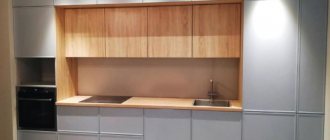The dining table should be well lit - who would like to look for food on the plate in the dark. Romantic dinners don't count!
Hang one or two lamps above the table, depending on the table configuration.
Distance to table
A pendant lamp in the kitchen above a table with a long cord should not hang too low - it will be easy to hit your head.
The lower edge of the lamp should be at least 100 cm above the table surface.
Place one lamp above the round table. The optimal diameter of the chandelier is about half the width of the table.
It is better to hang several pendant lamps over a long rectangular table - step back 30 cm from the edges of the table and place them at an equal distance from each other.
The best option for lighting the dining area are pendant lamps.
It is important that the lamp is beautiful, original, and unusual.
Design ideas
Two chandeliers can be hung above a large and elongated table. This way the lighting will be more harmonious, and the interior will take on an original look.
Ceiling lamps grouped in one place may have different suspension lengths. Thanks to lamps located at different heights, it will be possible to create a cascading light flow.
The painted product looks very unusual. For example, a stylish round lamp or a long rectangular lamp is decorated with interesting graffiti, bright paintings, mosaics or prints in the pin-up style.
The photo shows the interior of a kitchen in an apartment with two chandeliers on the ceiling above the dining group.
A lantern or chandelier with LED lamps is perfect for beautiful and high-quality lighting of a summer kitchen. Several devices with the ability to change the light intensity will create the most comfortable conditions. The optimal solution would be to install a two-key switch that allows you to control individual groups of light sources.
For safety reasons, the space is equipped with special electrical fittings that have additional protection against moisture in order to prevent a fire or short circuit.
How to adjust the height?
If your chandelier is on a chain, adjusting the height is very simple by reducing the number of links. If the lamp hangs on a cord, this cord can also be easily shortened to the desired size.
But if the lamp has a rigid mount, the so-called rod, it is not always possible to change its height.
Therefore, carefully study the information in the manufacturer’s catalog, make calculations, taking into account the height of your kitchen, and only then buy the right model.
Shape and size
Before choosing a lamp, decide on the size and shape. As a rule, the chandelier should not be larger than the width or diameter of the table. A single pendant lamp is usually used above a small round or square table. It can be small, or it can be impressive.
And just in this case, it is important to correctly calculate the diameter: subtract 30 cm from the diameter of the table, otherwise the lamp will “press with its volume” - those sitting at the table will feel discomfort.
Say, in a spacious room above a table with a diameter of 120 cm, a chandelier with a diameter of up to 90 cm will look beautiful and proportionate.
Which chandelier should you choose?
The choice depends on the size of the kitchen space.
The area of the room can be large or small, have a narrow, elongated configuration, high or low ceiling. When selecting a product, they also pay attention to kitchen furniture in the form of a set and a dining room group. You should decide on the light source before starting the repair. If a suspended ceiling is to be installed in the room, the chandelier must be purchased before installing the ceiling covering.
In style, the chandelier should be combined with the overall design of the kitchen and be a harmonious addition to the design, rather than being an accent detail. It is advisable to give preference to models that are not easily soiled. It is better if the lamp has a simpler shape without complex ornate elements, as it is more convenient to wash and clean.
The photo shows an elongated ceiling chandelier in the interior of a kitchen combined with a living room.
The chandelier should emit a moderately bright light stream that will not dazzle the eyes.
For a spacious room, it is appropriate to choose an elongated light source, because, unlike ordinary oval products, it illuminates more square meters.
If this room in the apartment is combined with a living room or dining room, two small chandeliers are hung in different areas in the kitchen.
How to move a lamp above a table?
Very often we see a situation where builders make an electrical connection for a lamp above the table approximately, give or take. And then it turns out that the chandelier hangs not where it is supposed to - ideally in the center of the table, but where it is necessary.
The case when the chandelier hangs in the center of the kitchen (unfortunate option)
This looks very sad, but there is a solution for this too! Choose a lamp with a long cord. Place the extra hook over the table and pull it through.
How to control the amount of light in the kitchen
Use a dimmer for the central chandelier or a 2.3-key switch, and all other lamps - general lighting, work area lighting, etc. - turn on using independent keys.
This is especially important with open floor plans, because in this way we not only create comfort for ourselves and our household members. But we also save energy.
A good solution is a height-adjustable lamp suspension: lower it lower when you want to create an intimate atmosphere at dinner or raise it to the ceiling if you need general, uniform lighting.
Location options
When considering location options, it is important to consider that the light should be as natural as possible. If the walls in the kitchen are light, then you can use fewer lighting fixtures.
Such lamps should be placed at different heights to enhance the effect.
The main lighting should be located on the ceiling. The main thing is to choose what it will be: a single chandelier or an LED strip around the entire perimeter. A long kitchen can be illuminated with several small chandeliers along the entire ceiling, which will be arranged in a row.
This solution is suitable for a rather large space, for example, for a kitchen combined with a dining room.
Above the dining area there are separate lamps that will correspond only to this area. The entire working surface is illuminated. It is important to highlight all areas, including cabinets.
In the kitchen, one discreet light-colored chandelier with an LED light bulb is enough to zone the dining area.
Lighting in any room must meet regulatory requirements and not harm vision. Be sure to place light bulbs throughout the room, covering all areas. Everyone chooses the type of lighting device themselves, based on the functions that need to be performed.
If the kitchen itself is decorated in white, then for a calm atmosphere you should use the same lamps.
How to hang a lamp above a table - design methods
Single lamp above the table
To create an atmosphere of intimacy and comfort, we use a pendant hanging low over the dining table.
Two identical lamps
If the light spot from a single lamp does not completely cover the surface of the dining table, find a companion for it.
If the table is large and elongated, make a line of single pendants, clearly defining the distance between the lamps.
Thin pendants are suitable for this, as in the photo above.
Two identical at different levels
If you have a large table, one light above it may not be enough. Instead of increasing the number of arms in your chandelier, break away from the patterns!
The height of the pendants does not have to be the same: asymmetry will add dynamics to an overly calm interior of the dining area.
Two identical pendants, different colors
Group of thin pendants
In interiors of a brutal nature, such as a style direction such as loft, thin pendants in the form of a set of lamps or a solid chandelier are often found.
Different pendants from the same series form a group
Light track
An elongated lamp over a long rectangular table
Chandelier over the dining table
Sconce lamp
Geometric lamp, pendulum
Group of identical lamps
Multi-level lighting in the dining area
Well, now let's talk about lighting scenarios. Previously, we were content with one general light and a table lamp for working and reading. Today, entire light symphonies are created that transform the environment depending on needs. When creating a lighting scenario, the following is taken into account:
- A combination of different types of lighting devices, point, diffuse, local.
- Characteristics of light sources (color temperature, ability to adjust brightness and direction of light flux, radiation intensity).
- Functional purpose of the room or its separate zone.
- Furniture arrangement.
- General style and color scheme of the room.
- Amount and features of natural light.
And many more nuances. Each embodied light scenario transforms the room, divides it into zones, and performs a decorative aesthetic function. Each dining area requires its own scenario, because for receiving guests and for a romantic dinner, different lighting solutions are needed. Various lighting fixtures will help create it.











